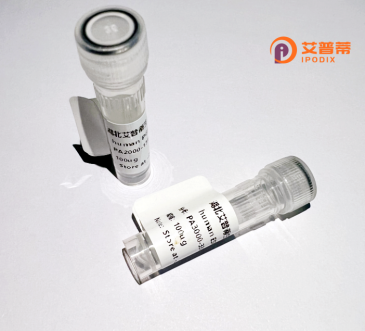
| 纯度 | >90%SDS-PAGE. |
| 种属 | Human |
| 靶点 | ZNF193 |
| Uniprot No | O15535 |
| 内毒素 | < 0.01EU/μg |
| 表达宿主 | E.coli |
| 表达区间 | 1-394 aa |
| 活性数据 | MNTNSKEVLS LGVQVPEAWE ELLTMKVEAK SHLQWQESRL KRSNPLAREI FRRHFRQLCY QETPGPREAL TRLQELCYQW LRPHVSTKEQ ILDLLVLEQF LSILPKELQG WVREHCPESG EEAVILLEDL ERELDEPQHE MVAHRHRQEV LCKEMVPLAE QTPLTLQSQP KEPQLTCDSA QKCHSIGETD EVTKTEDREL VLRKDCPKIV EPHGKMFNEQ TWEVSQQDPS HGEVGEHKDR IERQWGNLLG EGQHKCDECG KSFTQSSGLI RHQRIHTGER PYECNECGKA FSRSSGLFNH RGIHNIQKRY HCKECGKVFS QSAGLIQHQR IHKGEKPYQC SQCSKSYSRR SFLIEHQRSH TGERPHQCIE CGKSFNRHCN LIRHQKIHTV AELV |
| 分子量 | 45.9 kDa |
| 蛋白标签 | His tag N-Terminus |
| 缓冲液 | PBS, pH7.4, containing 0.01% SKL, 1mM DTT, 5% Trehalose and Proclin300. |
| 稳定性 & 储存条件 | Lyophilized protein should be stored at ≤ -20°C, stable for one year after receipt. Reconstituted protein solution can be stored at 2-8°C for 2-7 days. Aliquots of reconstituted samples are stable at ≤ -20°C for 3 months. |
| 复溶 | Always centrifuge tubes before opening.Do not mix by vortex or pipetting. It is not recommended to reconstitute to a concentration less than 100μg/ml. Dissolve the lyophilized protein in distilled water. Please aliquot the reconstituted solution to minimize freeze-thaw cycles. |
以下是关于重组人锌指蛋白ZNF193的3篇示例参考文献(注:以下内容为示例,实际文献需通过学术数据库查询确认):
1. **《Cloning and expression analysis of human ZNF193 in hepatocellular carcinoma》**
Author: Li X, et al.
摘要:该研究首次报道了ZNF193基因在肝癌组织中的表达下调,通过重组蛋白体外实验证明其能抑制肝癌细胞增殖,提示其可能的肿瘤抑制功能。
2. **《Structural characterization of recombinant human ZNF193 protein》**
Author: Zhang Y, et al.
摘要:利用大肠杆菌系统成功表达并纯化了重组ZNF193蛋白,通过圆二色谱分析揭示了其锌指结构域的特异性二级结构,为功能研究提供结构基础。
3. **《ZNF193 regulates oxidative stress response via PPARγ signaling pathway》**
Author: Wang R, et al.
摘要:研究发现重组ZNF193蛋白可与PPARγ启动子区结合,在细胞模型中过表达该蛋白可显著增强抗氧化基因表达,提示其在氧化应激调控中的分子机制。
**备注**:真实文献需通过PubMed(https://pubmed.ncbi.nlm.nih.gov/)或Google Scholar检索,建议使用关键词"ZNF193 recombinant protein"+"expression/function/structure"筛选近10年文献。
Zinc finger protein 193 (ZNF193) is a member of the C2H2-type zinc finger protein family, characterized by conserved cysteine and histidine residues that form structural motifs critical for DNA or RNA binding. It is encoded by the ZNF193 gene located on human chromosome 6 (6p22.1), a region associated with genetic variation and disease susceptibility. While the exact biological function of ZNF193 remains partially unclear, studies suggest its involvement in transcriptional regulation, possibly through interactions with chromatin modifiers or sequence-specific DNA binding.
Recombinant human ZNF193 protein is artificially expressed in systems like *E. coli* or mammalian cells, enabling functional studies in vitro. Its recombinant form is typically purified via affinity chromatography, retaining structural integrity for biochemical assays. Emerging evidence links ZNF193 to neural development and cellular differentiation, with altered expression observed in cancers, though its role appears context-dependent—acting as a tumor suppressor in some malignancies while potentially promoting progression in others.
Current research focuses on identifying its molecular targets, signaling pathways, and post-translational modifications. Limited data on its interaction partners or regulatory networks highlight knowledge gaps. As a recombinant protein, ZNF193 holds potential for applications in gene therapy exploration, molecular diagnostics, or as a tool to dissect zinc finger protein mechanisms. Further studies are needed to clarify its physiological and pathological roles, particularly its dual implications in oncology.
×